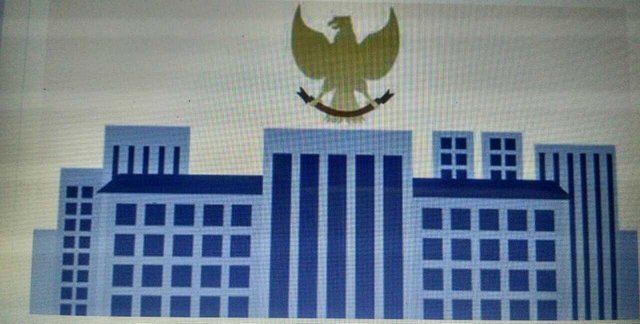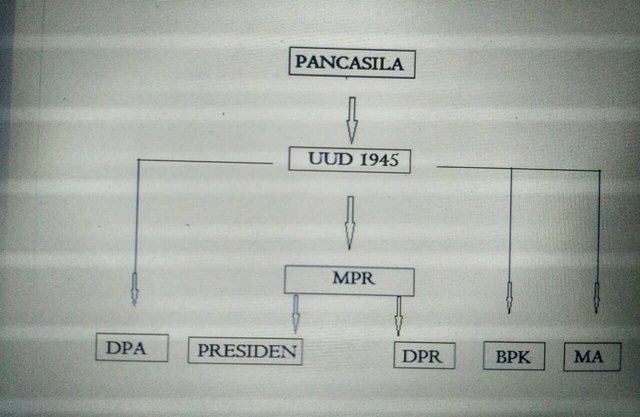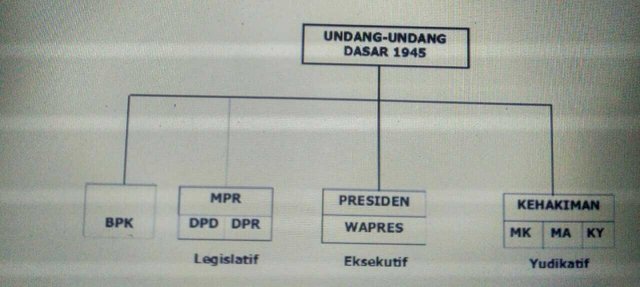***Implementation of Government System in Indonesia***
Once you learn about which system of governance is expanding in the world, now let us examine the Implementation of the governance system in Indonesia. Study each description carefully.
According to the 1945 Constitution, our state system of government does not embrace a purely Trias Politica system, but it embraces a system of power sharing (Distribution Power). This is because in the 1945 Constitution.
-It is not strictly limiting that any power must be exercised by a particular organization / body which should not interfere with one another.
-No limit the power is divided into 3 parts only and also do not limit the power done by 3 people only.
-Do not divide the people's power by the MPR, Article 1, paragraph 2, to other state institutions.

A. Principles of the Governing System of the Republic of Indonesia after the Amendment of the 1945 Constitution
-The form of the state is unity with the principle of broad autonomy. State territory consists of 34 provinces including special areas.
-The form of government is a republic, while its governmental system is presidential.
-The executive power holder is the president as head of state as well as head of government.
-Cabinet and minister are appointed and dismissed and accountable to the president.
Parliament consists of 2 rooms (bicameral) namely DPR and DPD which is also a member of the MPR. Members of the People's Legislative Assembly are elected by the people through elections coming from each province of 4 people each province with multiple district electoral system. In addition to the DPR and DPD bodies there are also Provincial DPRD and Regency or Municipal DPRD whose members are also elected through the election. The House of Representatives has the legislative power and the power to oversee the running of the government.
Judicial power is exercised by the supreme court and the lower courts, namely the high courts and the district courts and a Constitutional Court and the Judicial Commission.
B. Some Variations of Indonesia's Presidential Governmental System
-The President may be dismissed by the MPR at any time upon the proposal of the Parliament. So, the House still has the power to oversee the president though indirectly.
-The President in appointing state officials needs the considerations and approval of the DPR.
-The President in issuing certain policies needs the DPR's consideration and approval.
-Parliament is given greater power in terms of forming laws and budget rights.
Based on the above information, there are several changes in government system in accordance with the political dynamics of the Indonesian nation. It aims to improve the old presidency system.
The new changes include direct presidential elections, bicameral systems, checks and balances mechanisms and granting greater powers to parliament for oversight and budgetary functions.
C. State Structure of the Republic of Indonesia
In the constitutional structure there is the addition of the name of state institutions and the elimination of one state institution. Observe the following chart.

The above chart is the constitutional structure before the amendment of the 1945 Constitution.
The amendment structure after the amendment of the 1945 Constitution is as follows.
D. Pros and Cons of Implementation of Indonesian State Government System
Advantages of the Indonesian State Government System
-The existence of a statement that Indonesia is a state based on law and constitutional. This provides legal certainty and legal supremacy in the administration of state governments.
-MPR consisting of members of the People's Legislative Assembly and the People's Legislative Assembly, is authorized to amend the Constitution and to dismiss the president or vice-president within his term of office according to the Constitution. This has been done because the president is considered to have violated the state policy or the 1945 Constitution. For example, President Soekarno (1867), President B.J. Habibie (1999), and president of K.H. Abdurahman Wahid (2002).
-The position of president (executive) can not be overruled by the House, and vice president can not dissolve the House. The President cooperates with the Parliament in the drafting of the Act.
-The way the government tends to be more stable because the programs are relatively smooth and there is no cabinet crisis. This is possible because the cabinet (ministers) appointed and dismissed president only responsible to the president.
The weakness of the Indonesian State Government System
-Legal products have not been much in favor of the interests of the people.
-The MPR is a state institution loaded with political content so that its decisions and precision are highly dependent on the political constellation of the regime in power at the time. For example, during the New Order period the MPR's authority to amend the Constitution was never done, despite the many voices of the people who wanted an amendment.
-Lack of influential people's control over the government, so there is a tendency that more dominant executives may lead to authoritarianism. For example during the Old Order the president could dissolve the DPR and other state institutions were not functioning even as the president's aide. Similarly, during the New Order era even though there are other state institutions but kuran serves as where it should be.
-If ministers do not consist of honest, clean and professional people, government programs are not effective and the population (siding with society).
E. Current Governance System in Indonesia
-At the beginning of independence, our country uses a presidential government system that refers to the 1945 Constitution. Ministers are not accountable to the legislature but only acting as presidential aides.
-In November 1945, the Indonesian government system changed to parliamentary. Exactly when the issuance of the notice of Vice President. X, Announcement of the Working Body dated November 14, 1945, and the Notice of Governance on the same date. This system lasted until the Presidential Decree in 195.
Since the decree to date, the Indonesian state uses a presidential system.
So this article hopefully can add your insight about the Implementation of Government System in Indonesia and can be useful for everyone.

The above chart is the constitutional structure before the amendment of the 1945 Constitution. The amendment structure after the amendment of the 1945 Constitution is as follows.
D. Pros and Cons of Implementation of Indonesian State Government System
Advantages of the Indonesian State Government System
-The existence of a statement that Indonesia is a state based on law and constitutional. This provides legal certainty and legal supremacy in the administration of state governments.
-MPR consisting of members of the People's Legislative Assembly and the People's Legislative Assembly, is authorized to amend the Constitution and to dismiss the president or vice-president within his term of office according to the Constitution. This has been done because the president is considered to have violated the state policy or the 1945 Constitution. For example, President Soekarno (1867), President B.J. Habibie (1999), and president of K.H. Abdurahman Wahid (2002).
-The position of president (executive) can not be overruled by the House, and vice president can not dissolve the House. The President cooperates with the Parliament in the drafting of the Act.
-The way the government tends to be more stable because the programs are relatively smooth and there is no cabinet crisis. This is possible because the cabinet (ministers) appointed and dismissed president only responsible to the president.
The weakness of the Indonesian State Government System
-Legal products have not been much in favor of the interests of the people.
-The MPR is a state institution loaded with political content so that its decisions and precision are highly dependent on the political constellation of the regime in power at the time. For example, during the New Order period the MPR's authority to amend the Constitution was never done, despite the many voices of the people who wanted an amendment.
-Lack of influential people's control over the government, so there is a tendency that more dominant executives may lead to authoritarianism. For example during the Old Order the president could dissolve the DPR and other state institutions were not functioning even as the president's aide. Similarly, during the New Order era even though there are other state institutions but kuran serves as where it should be.
If ministers do not consist of honest, clean and professional people, government programs are not effective and the population (siding with society).
E. Current Governance System in Indonesia
-At the beginning of independence, our country uses a presidential government system that refers to the 1945 Constitution. Ministers are not accountable to the legislature but only acting as presidential aides.
-In November 1945, the Indonesian government system changed to parliamentary. Exactly when the issuance of the notice of Vice President. X, Announcement of the Working Body dated November 14, 1945, and the Notice of Governance on the same date. This system lasted until the Presidential Decree in 1959
Since the decree to date, the Indonesian state uses a presidential system.
So this article hopefully can add your insight about the Implementation of Government System in Indonesia and can be useful for everyone.